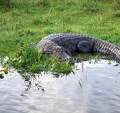|
Bariloche y alrededores |
The
Iberá lagoons and marshes are one of the biggest wildlife wetlands of the world. Located in the province of Corrientes, this ecosystem is the largest controlled area of the country covering 13,000 km2.
It shelters a vast variety of fauna and flora. The marshes have a great capacity to retain water, regulating the amount of rainwater - between 1200 and 1500 mm per year-. About one quarter of the water flows to River Paraná through the only superficial drainage system, River Corrientes. Vegetation is charged of the rest of the water perspiring and evaporating it. So we may say that the Iberá is a real and efficient dam that controls the flow of
water.
 The marshes are real floating islands (80% of the reserve) formed in the terrain when water cannot drain away from it. They are several feet thick and have trees and bushes that grow due to the nourishment of the soil. The wetlands are composed mainly of marshes, lagoons, and pluvial streams. About 30% are well-delimited lagoons - more than 60- that are 2 or 3 metres deep covering about 315 km2. The dams and their origin in the form of water lilies Over their vegetal tissue dust settles creating a first layer of earth that allows plants, even trees, to grow. They are real "floating costs". The firmest parts can support trees -laurel, coral tree, curupí- although straw prevails -totora, pehuhajó, espadaña, paja brava-. The marshes are real floating islands (80% of the reserve) formed in the terrain when water cannot drain away from it. They are several feet thick and have trees and bushes that grow due to the nourishment of the soil. The wetlands are composed mainly of marshes, lagoons, and pluvial streams. About 30% are well-delimited lagoons - more than 60- that are 2 or 3 metres deep covering about 315 km2. The dams and their origin in the form of water lilies Over their vegetal tissue dust settles creating a first layer of earth that allows plants, even trees, to grow. They are real "floating costs". The firmest parts can support trees -laurel, coral tree, curupí- although straw prevails -totora, pehuhajó, espadaña, paja brava-.
The marshes are water deposits that are 1 or 3 metres deep covered with aquatic plants; they may also be floating formations that hide the surface with large communities of water lilies or in the form of dams. The latter grow in the marshes and in the margins of the rivers and lagoons. They are composed of floating plants like the aguapé, the irupé, the repollito and the water lentils. The bañados (type of swamp) are another characteristic formation of the region, formed by the temporary accumulation of water in low areas.
The water flows to rivulets or is absorbed by the soil, remaining only in the deepest places. When the area is extremely low the bañados create a weak floor known as ¨malezal¨.
|
 |






